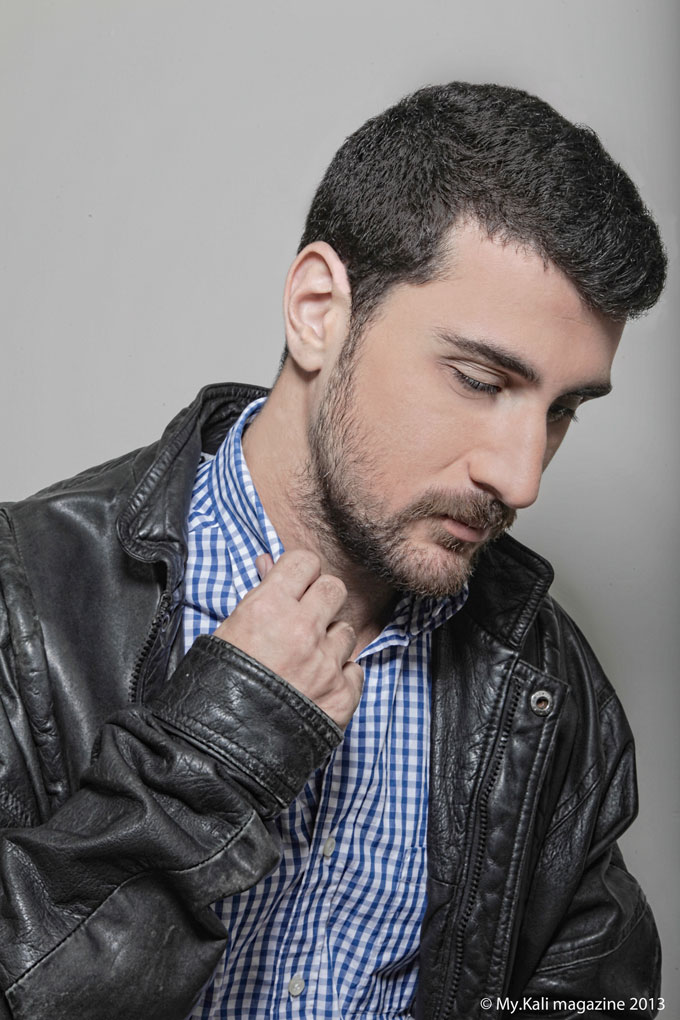(Picture: Haig is wearing a white and blue checked shirt from Massimo Dutti, a second-hand leather jacket from Amman's most famed flea-mareket, Abdali.)
The golden stage curtain shimmered in the background. Her outfit had similar hues and texture yet she stood out. The belly dancer stood out with every movement and facial expression she made. The magenta tone gave her swaying body a mesmerizing allure. You couldn’t take your eyes of her. You hear Hamed Sinno, the lead vocalist of Mashrou’ Leila, more than you see him.
A few minutes into the video, Lil Watan, you catch a glimpse of the lead violinist in this giddy performance, as he approvingly waves his bow at the dancing seductress. Well, a few days later I interviewed that violinist, Haig Papazian, Mashrou’ Leila’s violinist. When I entered the hotel lobby Mr. Papazian was already being interviewed, by My.Kali‘s very own music page editor. The publicist, who received me, asked if 10 minutes were enough for an interview. I said yes. I lied. I had a lot of questions and I had every intention to ask them all, which I did.
One can tell that Papazian would rather be on a stage performing, or spending countless hours in a studio recording music with his bandmates, instead of sitting with a complete stranger answering questions that might take him by surprise, or bore him if they were the familiar lazy journalistic questions. Artists and musicians usually don’t like to explain their works or songs; at least not from the very start of an interview, which is why I asked the mild mannered Lebanese musician to tell me who he thought Haig Papazian was.
The following are the questions and answers from Haig Papazian’s interview for My.Kali magazine.
Mike V. Derderian: Who are you in your own words? Who is Haig Papazian?
Haig Papazian: A lot of people know me as the violinist and musician part of Mashrou’ Leila. All of us in the band have a lot of side projects as well.
I’ve been playing music since I was a kid. I studied violin. I went to this Armenian music school.
One of the reasons we started Mashrou’ Leila was we did not want to quit music because we were studying architecture. We all have our careers in architecture, design and engineering; and we’ve been working on them.
A lot of our work and input in Mashrou’ Leila comes from our backgrounds. Our other projects affect us and affect our music. Everything is connected. It comes hand in hand. I’ve been working in architecture and research for the past five years, however, I also been focusing on artistic work like conceptual art and contemporary art as in videos, installations and illustrations.
Everything comes hand in hand. My artistic and architectural work affects a lot how I perceive music and the spatial part, and the image of Mashrou’ Leila.
MVD: What other roles in Mashrou’ Leila do you have in addition to being the violinist?
HP: We all write music together. On stage and at this point I play the violin, percussions and other instruments depending on the setting and the setup. When we are writing the music we all compose together.
We do almost everything and somehow, ever since we started Mashrou’ Leila, I was in charge of our social media. We were able to use social media to our advantage.
There was a certain boom happening back then in 2008. We were just writing music and putting it online and people were reacting to it. It started to create an image of what Mashrou’ Leila is and what it represents.
It all evolved from the letters we used to send to the fan page about this girl, Leila. Who is Leila; who is writing the messages; inviting people to dance with her; talking about her sister; talking about revolutions; talking about music; and who is talking about her lovers?
It was all part of the identity. In the beginning it wasn’t thought of or planed. It was driven by the reaction of the people until we started working on it.


